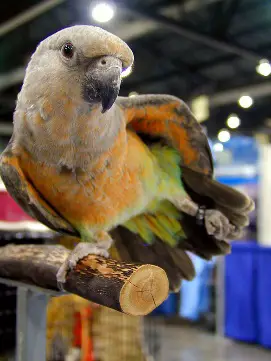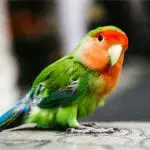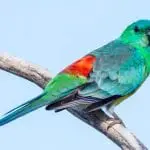Scientific Facts
| Common Name | Red-bellied Parrot |
| Scientific Name | Poicephalus rufiventris |
| Lifespan | 20 – 25 Years |
| Size | 8.6 inches (22cm) |
| Body Mass | 4 – 5oz. (113 – 142grams) |
| Habitat | Semi-arid vegetation |
| Range | Somalia, Ethiopia, Tanzania |
Information & Physical Appearance
The Red-bellied Parrot is scientifically referred to as Poicephalus rufiventris.
Poicephalus rufiventris is classified in the order Psittaciformes, the family Psittacidae, the tribe Psittacini, the genus Poicephalus.
Other common names include
Orange-bellied Parrot (not to be confused with the Orange-bellied parrot (Neophema chrysogaster), which is endemic to southern Australia,)
Red-breasted Parrot,
Abyssinian Parrot,
African Orange-bellied Parrot.
There are no recognized subspecies.
Red-bellied Parrots are small-sized birds, weighing up to 140 grams (5oz.) and measuring up to 8.6 inches (22cm) in length.
These parrots are sexually dimorphic, and so it is easy to tell apart an adult male from an adult female.
In both sexes, the plumage is mostly greenish and grey. Green coloration is more prominent over the lower surfaces of the body, while the grey coloration is more prominent on the upper parts of the body.
Adult males and females alike have green feathers that cover the upper portions of the legs. The iris is red/orange, and the beak is dark grey.
Adult males are characterized by grey/brown body coloration. There are tinges of brown/orange on the breast zone, as well as on the cheeks. Note that the amount of blue/orange tinges varies among individuals.
The underwing coverts, the lower breast, and the abdomen display orange coloring.
The thighs are pale green/blue in color, and so is the area that extends from the lower flanks to the undertail coverts. The upper tail coverts are washed with blue, while the rump is yellow/green.
The bare eye ring is colored in brown/grey.
In adult females, the area that starts from the lower breast and reaches the undertail coverts displays green coloration.
The uppertail coverts, as well as the rump, are green in color, with the blue suffusion that is seen in males being absent in females.
Juveniles
Juveniles closely resemble the physical appearance of adult females, with the major difference that juveniles’ plumage is duller and paler in general.
Immature males display orange wash on the breast and on the underwing coverts.
Another difference that sets apart juveniles from adults is that the bare eye ring is paler grey in immature individuals. Also, the iris of the eye is brown, instead of orange/red, as seen in adults.
Lifespan

Image Source
Red-bellied parrots have an average lifespan of 15 – 25 years. However, when given proper care, these parrots can possibly live up to 30+ years of age.
Ecosystem & Habitat

Image Source
RANGE
Red-bellied parrots are small African parrots. Their native range spans across Somalia, northeastern Tanzania, as well as southern and eastern Ethiopia.
HABITAT
Red-breasted parrots are known to avoid dense foliage. Instead, the preferred type of habitat is semi-arid vegetation.
These parrots can be found in Acacia-Commiphora steppe woodlands and in dry bush areas, too.
Red bellies occur at elevations that vary between 2624 and 6560ft. (800 – 2000 meters).
Food & Diet

Image Source
Orange-bellied parrots are strictly vegetarian. In the wild, their diet consists of various seeds, fruits, and maize.
Ficus figs are a favorite delicacy.
Behavior
Red-bellied parrots are usually seen in pairs or in small family groups. These family groups consist of 3 and up to 4 members.
Because of drinking water quite frequently, this parrot species can be often found near water bodies/sources.
Red bellies sometimes prefer to nest in loose colonies. The pairs in these colonies are typically 328 – 656ft. (100 – 200 meters) apart from each other.
Reproduction
The start of the breeding season for red-bellied parrots varies depending on locality.
In Tanzania, orange-bellied parrots begin to breed in March, and the season lasts throughout October.
In Ethiopia, the breeding season starts in May.
Females are to lay a max of 3 rounded eggs that measure 1 x 0.9 inches in size.
The incubation period takes about 24 – 26 days. Upon hatching, the young chicks weigh as little as 0.2oz. (7grams).
It is within 10 weeks after hatching that the young red-bellied parrots reach their fledgling age.
Survival Threats & Conservation

Image Source
Poicephalus rufiventris is classified under the Least Concern category on the IUCN Red List of Threatened Species.
Also, red-bellied parrots are listed on CITES’ Appendix II and are, therefore, subject to international trade controls.
There is no systematic monitoring scheme for this species, and so the world population remains unknown. The population trend is considered stable based on the 2016 global assessment.
Also, the population is not severely fragmented, and conservation sites are identified over the entire range. Furthermore, there are controlled breeding programs.
The major survival threat is none other but the trapping of these birds for the exotic bird trade.
Availability – Where to Get a Red-bellied Parrot
Red-bellied parrots are widely available for sale and are commonly kept as pets.
You can acquire one of these feathery fellows from a variety of avian-specialty stores, both online and offline.
Also, it can be a great idea to acquire a red-bellied parrot directly from a trustworthy breeder.
Interesting Facts
1. The sexual dimorphism in red-bellied parrots occurs from a young age. You can tell apart a young male from a young female even by simply looking at the young chicks in the nest. Males’ underwing coverts and breast are washed with orange, which is absent in females.
2. It almost goes without saying that the name “red-bellied parrot” suggests that this species has hints of red, yet there is another common name for this parrot – “orange-bellied parrot.”
However, the very word for orange color was not introduced into the English language prior to the fruit orange having been discovered and then named.
Thus, some animals colored in orange were named red because of the fact that the word “orange” denoting the color orange did not really exist in English back in time when certain animal species were first described. And this is exactly the case with the red-bellied parrot!
3. Red-Bellied parrots are regarded as the best speaking parrots in their genus.
How to Care for the Red-bellied Parrot
1. Housing
A walk-in enclosure will work excellently for housing a red-bellied parrot, and so will a suspended cage, as long as these measure at least 6.5ft. (2 meters) in length.
Being the active and curious creatures that they are, red bellies should be provided with a variety of ladders, swings, puzzle toys, bird-safe, non-toxic vegetable-tanned leather toys, wood toys, foraging toys, as well as noise-makers (e.g., bells).
Important Note
Keeping good hygiene within the enclosure is the best way to prevent diseases. For this purpose, food and water dishes, toys and accessories, bathing accessories, as well as the cage itself, should be carefully cleaned on a regular basis.
2. Diet
As a rule of thumb, fruits, seeds, and Acacia plants make the most favorite foods for red bellies in the wild.
Owners should stick with a balanced, varied captive diet that mimics these creatures’ wild diet.
Suitable foods include cooked pulses and beans, dry, sprouted, or soaked sunflower seeds, boiled maize, oranges, cactus fruits, bananas, pomegranates, celery, fresh corn, carrots, spray millet and green leaves.
Note that fruits and veggies should be served daily.
A good start of a healthy dies it a high-quality seed mix for parrots.
Rearing food consists of wholegrain bread, carrots, as well as hard-boiled eggs ground to a crumbly consistency.
Cuttlebone makes an excellent addition to ensure a substantial amount of essential vitamins and nutrients.
3. Speech & Sounds
Red-bellied parrots are great talkers, just like most parrots that are endemic to Africa.
Red bellies are capable of picking up simple words starting from a very early age. Over time, they can build a small vocabulary, consisting mainly of commonly repeated sounds and words.
Note that these parrots are to mimic and chat as much as they want and like to, in a clear voice that is often described as slightly “artificial.”Most importantly, red bellies are not too noisy. They can make wonderful pets for those living in apartment settings.
4. Personality
Orange-bellied parrots are renowned for their fun personalities.
They are sociable, energetic, and friendly in general.
They do require plenty of freedom to explore their environment, as well as free time outside the cage, where they can play with their toys.
Also, red bellies may enjoy some cuddling every now and then.
They have a natural tendency to learning new tricks. They love to chat and can be quite silly, entertaining, acrobatic little birds to keep as pets.
Mind that they can become nippy at times, though.
These parrots may go through difficult stages before the owner manages to earn their love, but once their trust and affection are won, they will quickly become a favorite member of the entire family.
It is important to keep in mind that red-bellied parrots can become “one-person birds” quite easily. To avoid this, you need to socialize them with other people and/or pets regularly.
Another important thing about their temper and personality is that they are prone to panic attacks. Make sure they feel safe at all times to avoid this.
In the case you red belly pet is to get scared and flutter away from something, it is imperative not to chase them, as this will often make them even more terrified.
The right thing to do is to simply call them and let them come seek comfort on their own instead of forcing them to do so.
5. Possible Health Issues
In general, red-bellied parrots are regarded as hardy, robust birds. They are capable of spending their lifespan without encountering many (or any) health troubles along the way. Providing a good amount of interaction and attention is key to keeping red bellies healthy and happy. Also, regular checkups with a qualified vet are crucial.
Don’t underestimate the importance of providing a lot of free space.
If you notice abnormal signs, such as lethargy, labored breathing, apathy, and/or loss of appetite, consult with a qualified vet as soon as feasible.
It is a must to avoid exposing your feathery fellow to extreme cold, heat, and/or drafts, as these can quickly deteriorate the health of your pet.
FAQ Section
Are Red-bellied Parrots Good Pets?
Red-bellied parrots are commonly kept as pets and are favorite species for many bird lovers. They make good pets for the right owners who can provide regular care and attention for their feathery friends to thrive, rewarding their caregivers with affection and plenty to smile about with their acrobatic tricks and mimicking skills.
Are Red-bellied Parrots Loud?
Red-bellied parrots are not as noisy and loud as other parrot species. They do not tend to continuously screech or squawk while begging for attention, and even though they are capable of making a variety of noises and sounds (whistles included), they are much quieter than other cockatoos, making suitable pets for apartment dwellers.
Are Red-bellied Parrots Good Talkers?
Yes, red-bellied parrots are renowned as good talkers, capable of making a range of sounds, such as whistles, as well as mimicking human speech in a very clear voice.Sometimes, red bellies can start mimicking human words even before they are weaned, and are always ready to just blurt something out, surprising their owners and giving them a good laugh.
How Long Do Red-bellied Parrots Live?
The average lifespan of red-bellied parrots is estimated at 20 years. However, with proper care, love, and attention, they are capable of reaching over 30 years of age.
How Much Is a Red-bellied Parrot?
Red-bellied parrots are quite affordable and are widely available through breeders and pet stores. You can find red bellies available for sale at prices that range from around $400 to $600.
Are Red-bellied Parrots Endangered?
Red-bellied parrots are not critically endangered with extinction. Even though they are listed on the IUCN Red List of Threatened Species under the Least Concern category, the world population is estimated as stable.



